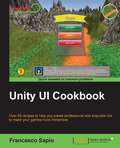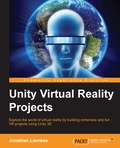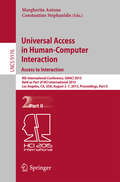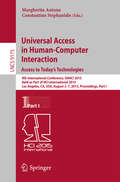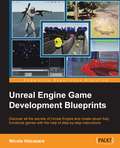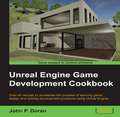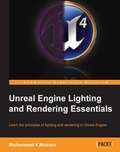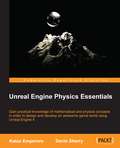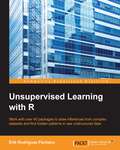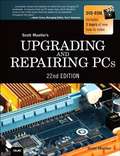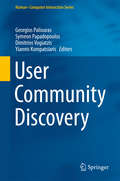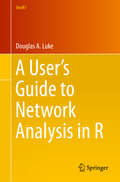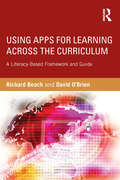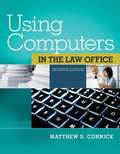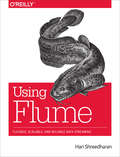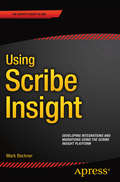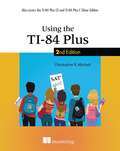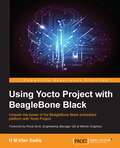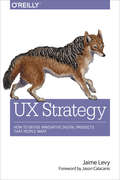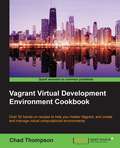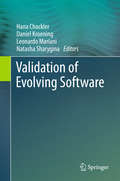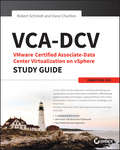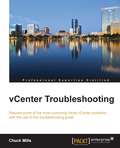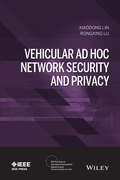- Table View
- List View
Unity UI Cookbook
by Francesco SapioOver 60 recipes to help you create professional and exquisite UIs to make your games more immersive About This Book * Design and develop interactive and professional user interfaces (UIs) for games in Unity * Discover how to implement and deal with various in-game UI elements that will impress your players * This practical recipe guide will help you to efficiently create powerful and remarkable UIs using C# code Who This Book Is For If you are a game developer with some experience in Unity and C# and want to create the best interactive experience fast and intuitively, then this book is for you. If you are an intermediate game developer or an expert, these recipes will help you bring out the power of the new UI Unity system. What You Will Learn * Implement different kinds of counters and healthbars * Deal with timers and find out how to format them * Animate and vivify UI elements * Handle runtime customizations * Add complex Head-up displays (HUDs) * Design and implement 3D UIs * Integrate minimaps in the UI In Detail With the increasing interest in game development, it's essential to design and implement a UI that reflects the game settings and shows the right information to the player. The Unity system is used to create complex and aesthetically pleasing user interfaces in order to give a professional look and feel to a game. Although the new Unity UI system is powerful and quite easy to use, by integrating it with C# scripts, it's possible to realize the potential of this system and bring an impressive UI to games. This guide is an invaluable collection of recipes if you are planning to use Unity to develop a game. Starting with the basic concepts of the UI components, we'll take you all the way through to creating complex interfaces by including animations and dynamics elements. Based on real-world problems, these recipes will start by showing you how to make common UI elements such as counters and healthbars. You will then get a walkthrough of how to manage time using timers, and will learn how to format them. You will move on to decorating and animating the UI elements to vivify them and give them a professional touch. Furthermore, you will be guided into the 3D UI world and into HUD scripting. Finally, you will discover how to implement complex minimaps in the interface. Style and approach Interactive, easy-to-follow recipes will help you create and implement UIs that make gaming an exhilarating experience.
Unity Virtual Reality Projects
by Jonathan LinowesExplore the world of Virtual Reality by building immersive and fun VR projects using Unity 3D About This Book * Learn the basic principles of virtual reality applications and get to know how they differ from games and desktop apps * Build various types of VR experiences, including diorama, first-person characters, riding on rails, 360 degree projections, and social VR * A project-based guide that teaches you to use Unity to develop VR applications, which can be experienced with devices such as the Oculus Rift or Google Cardboard Who This Book Is For If you're a non-programmer unfamiliar with 3D computer graphics, or experienced in both but new to virtual reality, and are interested in building your own VR games or applications then this book is for you. Any experience in Unity is an advantage. What You Will Learn * Create 3D scenes with Unity and Blender while learning about world space and scale * Build and run VR applications for consumer headsets including Oculus Rift and Google Cardboard * Build interactive environments with physics, gravity, animations, and lighting using the Unity engine * Experiment with various user interface (UI) techniques that you can use in your VR applications * Implement the first-person and third-person experiences that use only head motion gestures for input * Create animated walkthroughs, use 360-degree media, and build multi-user social VR experiences * Learn about the technology and psychology of VR including rendering, performance and VR motion sickness * Gain introductory and advanced experience in Unity programming with the C# language In Detail What is consumer "virtual reality"? Wearing a head-mounted display you view stereoscopic 3D scenes. You can look around by moving your head, and walk around using hand controls or motion sensors. You are engaged in a fully immersive experience. On the other hand, Unity is a powerful game development engine that provides a rich set of features such as visual lighting, materials, physics, audio, special effects, and animation for creating 2D and 3D games. Unity 5 has become the leading platform for building virtual reality games, applications and experiences for this new generation of consumer VR devices. Using a practical and project-based approach, this book will educate you about the specifics of virtual reality development in Unity. You will learn how to use Unity to develop VR applications which can be experienced with devices such as the Oculus Rift or Google Cardboard. We will then learn how to engage with virtual worlds from a third person and first person character point of view. Furthermore, you will explore the technical considerations especially important and possibly unique to VR. The projects in the book will demonstrate how to build a variety of VR experiences. You will be diving into the Unity 3D game engine via the interactive Unity Editor as well as C-Sharp programming. By the end of the book, you will be equipped to develop rich, interactive virtual reality experiences using Unity. So, let's get to it! Style and approach This book takes a practical, project-based approach to teach specifics of virtual reality development in Unity. Using a reader-friendly approach, this book will not only provide detailed step-by-step instructions but also discuss the broader context and applications covered within.
Universal Access in Human-Computer Interaction. Access to Interaction
by Margherita Antona Constantine StephanidisThe four LNCS volume set 9175-9178 constitutes the refereed proceedings of the 9th International Conference on Learning and Collaboration Technologies, UAHCI 2015, held as part of the 17th International Conference on Human-Computer Interaction, HCII 2015, in Los Angeles, CA, USA in August 2015, jointly with 15 other thematically similar conferences. The total of 1462 papers and 246 posters presented at the HCII 2015 conferences were carefully reviewed and selected from 4843 submissions. These papers of the four volume set address the following major topics: LNCS 9175, Universal Access in Human-Computer Interaction: Access to today's technologies (Part I), addressing the following major topics: LNCS 9175: Design and evaluation methods and tools for universal access, universal access to the web, universal access to mobile interaction, universal access to information, communication and media. LNCS 9176: Gesture-based interaction, touch-based and haptic Interaction, visual and multisensory experience, sign language technologies and smart and assistive environments LNCS 9177: Universal Access to Education, universal access to health applications and services, games for learning and therapy, and cognitive disabilities and cognitive support and LNCS 9178: Universal access to culture, orientation, navigation and driving, accessible security and voting, universal access to the built environment and ergonomics and universal access.
Universal Access in Human-Computer Interaction. Access to Today's Technologies
by Margherita Antona Constantine StephanidisThe four LNCS volume set 9175-9178 constitutes the refereed proceedings of the 9th International Conference on Learning and Collaboration Technologies, UAHCI 2015, held as part of the 17th International Conference on Human-Computer Interaction, HCII 2015, in Los Angeles, CA, USA in August 2015, jointly with 15 other thematically similar conferences. The total of 1462 papers and 246 posters presented at the HCII 2015 conferences were carefully reviewed and selected from 4843 submissions. These papers of the four volume set address the following major topics: LNCS 9175, Universal Access in Human-Computer Interaction: Access to today's technologies (Part I), addressing the following major topics: LNCS 9175: Design and evaluation methods and tools for universal access, universal access to the web, universal access to mobile interaction, universal access to information, communication and media. LNCS 9176: Gesture-based interaction, touch-based and haptic Interaction, visual and multisensory experience, sign language technologies, and smart and assistive environments LNCS 9177: Universal Access to Education, universal access to health applications and services, games for learning and therapy and cognitive disabilities and cognitive support and LNCS 9178: Universal access to culture, orientation, navigation and driving, accessible security and voting, universal access to the built environment and ergonomics and universal access.
Unreal Engine Game Development Blueprints
by Nicola ValcasaraDiscover all the secrets of Unreal Engine and create seven fully functional games with the help of step-by-step instructions About This Book * Understand what a Blueprint is and how to create a complex visual scripting code * Discover the infinite possibilities that Unreal Engine offers, and understand which tool to use, where and when * Learn to think like a real game developer in order to create enjoyable and bug-free games using this comprehensive and practical handbook Who This Book Is For This book is ideal for intermediate level developers who know how to use Unreal Engine and want to go through a series of projects that will further their expertise. Working knowledge of C++ is a must. What You Will Learn * Write clean and reusable Blueprint scripts * Develop any kind of game you have in mind, following the rules used by experts * Move through Unreal Engine 4, always knowing what you are doing and where to find the right tool for your needs * Integrate C++ code into your projects using Visual Studio and the tools that Unreal provides * Extricate between classes, nodes, interfaces, macros, and functions * Work with different types of assets, from 3D objects to audio sources, from UI buttons to animations * Explore all the aspects of the game logic--collisions, navigation meshes, matinees, volumes, events, and states In Detail With the arrival of Unreal Engine 4, a new wonderful tool was born: Blueprint. This visual scripting tool allows even non-programmers to develop the logic for their games, allowing almost anyone to create entire games without the need to write a single line of code. The range of features you can access with Blueprint script is pretty extensive, making it one of the foremost choices for many game developers. Unreal Engine Game Development Blueprints helps you unleash the real power of Unreal by helping you to create engaging and spectacular games. It will explain all the aspects of developing a game, focusing on visual scripting, and giving you all the information you need to create your own games. We start with an introductory chapter to help you move fluidly inside the Blueprint user interface, recognize its different components, and understand any already written Blueprint script. Following this, you will learn how to modify generated Blueprint classes to produce a single player tic-tac-toe game and personalize it. Next, you will learn how to create simple user interfaces, and how to extend Blueprints through code. This will help you make an informed decision between choosing Blueprint or code. You will then see the real power of Unreal unleashed as you create a beautiful scene with moving, AI controlled objects, particles, and lights. Then, you will learn how to create AI using a behavior tree and a global level Blueprint, how to modify the camera, and how to shoot custom bullets. Finally, you will create a complex game using Blueprintable components complete with a menu, power-up, dangerous objects, and different weapons. Style and approach This is an easy-to-follow guide full of practical game examples. Each chapter contains step-by-step instructions to build a complete game and each game uses a different tool in order to cover all the topics in a detailed and progressive manner.
Unreal Engine Game Development Cookbook
by John P. DoranOver 40 recipes to accelerate the process of learning game design and solving development problems using Unreal EngineAbout This BookExplore the quickest way to tackle common challenges faced in Unreal EngineCreate your own content, levels, light scenes, and materials, and work with Blueprints and C++ scriptingAn intermediate, fast-paced Unreal Engine guide with targeted recipes to design games within its frameworkWho This Book Is ForThis book is for those who are relatively experienced with Unreal Engine 4 and have knowledge of its fundamentals. Working knowledge of C++ is required.What You Will LearnDiscover editor functionalities for an in-depth insight into game designDevelop environments using terrain for outdoor areas and a workflow for interiors as well using brushesDesign various kinds of materials with unique features, such as mirrors and glowsExplore the various ways that lighting can be used in the engineBuild various level effects using Blueprints, Unreal's visual scripting systemSet up a development environment and develop custom functionality with C++ for your gamesCreate healthbars and main menus with animations using Slate, Unreal's UI solution, through the UMG EditorPackage and create an installer to get your project out into the worldIn DetailUnreal Engine is powerful tool with rich functionalities to create games. It equips you with the skills to easily build mobile and desktop games from scratch without worrying about which platform they will run on. You can focus on the individual complexities of game development such as animation and rendering.This book takes you on a journey to jumpstart your game design efforts. You will learn various aspects of the Unreal engine commonly encountered with practical examples of how it can be used, with numerous references for further study. You will start by getting acquainted with Unreal Engine 4 and building out levels for your game. This will be followed by recipes to help you create environments, place meshes, and implement your characters. You will then learn to work with lights, camera, and shadows to include special effects in your game. Moving on, you'll learn Blueprint scripting and C++ programming to enable you to achieve trigger effects and add simple functionalities. By the end of the book, you will see how to create a healthbar and main menu, and then get your game ready to be deployed and published.Style and approachThis book offers detailed, easy-to-follow recipes that will help you master a wide range of Unreal Engine 4's features. Every recipe provides step-by-step instructions, with explanations of how these features work, and alternative approaches and research materials so you can learn even more.
Unreal Engine Lighting and Rendering Essentials
by Muhammad A. MoniemLearn the principles of lighting and rendering in the Unreal Engine About This Book * Get acquainted with the concepts of lighting and rendering specific to Unreal * Use new features such as Realistic Rendering and Foliage Shading to breathe new life into your projects * A fast-paced guide to help you learn lighting and rendering concepts in Unreal Who This Book Is For This book is meant for game developers with knowledge of Unreal Engine and a basic understanding of lighting and rendering systems in it. As a prerequisite, you need to have good knowledge of C++. What You Will Learn * Use features such as realistic Rendering and Foliage Shading to create high quality output * Create and edit your materials using the Material Editor * Use Cascade's particle editor to create modular particle-based effects using emitters * Explore Unreal's GPU Visualizer * Tweak the overall look and feel of your scene with post-process effects * Create charts to get stat unit times over a long period of time * Use scalability settings to maintain performance for your games on different platforms and hardware In Detail Unreal Engine is a powerful game development engine that provides rich functionalities to create 2D and 3D games. Developers have the opportunity to build cross-platform mobile and desktop games from scratch. Unreal Engine enables users to create high quality games that focus on individual complexities of game development. This book provides you with the skills required to apply a high level of visual appeal to your games without compromising on performance. Starting with an introduction to the rendering system, you will learn to create different types of materials using the Material Editor. You will then create a particle system based on Cascade editor to create mind-blowing visual effects. Moving on, you will learn the concept of lights in Unreal and different types of dynamic/real-time lights, along with a number of powerful post processing effects. Next, you will learn to improve rendering performance, keeping in mind the rendering limitations for different platforms. At the end of the book, we will discuss the scalability settings menu, and how to add realistic fog effects based on the requirements of your game or level. Style and approach A fast-paced guide filled with hands-on examples to teach you the principles of lighting and rendering in Unreal.
Unreal Engine Physics Essentials
by Devin Sherry Katax EmperoreGain practical knowledge of mathematical and physics concepts in order to design and develop an awesome game world using Unreal Engine 4 About This Book * Use the Physics Asset Tool within Unreal Engine 4 to develop game physics objects for your game world * Explore the Collision mechanics within Unreal Engine 4 to create advanced, real-world physics * A step-by-step guide to implementing the Physics concepts involved in Unreal Engine 4 to create a working Vehicle Blueprint Who This Book Is For This book is intended for beginner to intermediate users of Epic Games' Unreal Engine 4 who want to learn more about how to implement physics within their game-world. No matter what your knowledge base of Unreal Engine 4 is, this book contains valuable information on blueprint scripting, collision generation, materials, and the Physical Asset Tool (PhAT) for all users to create better games. What You Will Learn * Get to know basic to intermediate topics in mathematics and physics * Create assets using the Physics Asset Tool (PhAT) in Unreal Engine 4 * Develop Collision Hulls, which are necessary to take advantage of Unreal Engine 4's physics and collision events * Use constraints to create advanced physics-based assets for your game-world * Working knowledge of physics bodies, physics damping, and friction within Unreal Engine 4 * Develop physical materials to recreate real-world friction for substances such as glass and ice * Create a working vehicle blueprint from scratch using assets provided by Unreal Engine 4 * Gain knowledge about implementing advanced physics in Unreal Engine 4 using C++ programming In Detail Unreal Engine 4 is one of the leading game development tools used by both AAA and independent developers alike to create breathe-taking games. One of the key features of this tool is the use of Physics to create a believable game-world for players to explore. This book gives readers practical insight into the mathematical and physics principles necessary to properly implement physics within Unreal Engine 4. Discover how to manipulate physics within Unreal Engine 4 by learning basic real-world mathematical and physics concepts that assist in the implementation of physics-based objects in your game world. Then, you'll be introduced to PhAT (Physics Asset Tool) within Unreal Engine 4 to learn more about developing game physics objects for your game world. Next, dive into Unreal Engine 4's collision generation, physical materials, blueprints, constraints, and more to get hands-on experience with the tools provided by Epic to create real-world physics in Unreal Engine 4. Lastly, you will create a working Vehicle Blueprint that uses all the concepts covered in this book, as well as covering advanced physics-based topics. Style and approach An easy-to-follow reference text filled with working examples of physics within Unreal Engine 4. Each topic is broken down to easily explain how to implement physics and physical objects in your game-world using the tools provided by Epic Games Unreal Engine 4.
Unsupervised Learning with R
by Erik Rodriguez PachecoWork with over 40 packages to draw inferences from complex datasets and find hidden patterns in raw unstructured data About This Book * Unlock and discover how to tackle clusters of raw data through practical examples in R * Explore your data and create your own models from scratch * Analyze the main aspects of unsupervised learning with this comprehensive, practical step-by-step guide Who This Book Is For This book is intended for professionals who are interested in data analysis using unsupervised learning techniques, as well as data analysts, statisticians, and data scientists seeking to learn to use R to apply data mining techniques. Knowledge of R, machine learning, and mathematics would help, but are not a strict requirement. What You Will Learn * Load, manipulate, and explore your data in R using techniques for exploratory data analysis such as summarization, manipulation, correlation, and data visualization * Transform your data by using approaches such as scaling, re-centering, scale [0-1], median/MAD, natural log, and imputation data * Build and interpret clustering models using K-Means algorithms in R * Build and interpret clustering models by Hierarchical Clustering Algorithm's in R * Understand and apply dimensionality reduction techniques * Create and use learning association rules models, such as recommendation algorithms * Use and learn about the techniques of feature selection * Install and use end-user tools as an alternative to programming directly in the R console In Detail The R Project for Statistical Computing provides an excellent platform to tackle data processing, data manipulation, modeling, and presentation. The capabilities of this language, its freedom of use, and a very active community of users makes R one of the best tools to learn and implement unsupervised learning. If you are new to R or want to learn about unsupervised learning, this book is for you. Packed with critical information, this book will guide you through a conceptual explanation and practical examples programmed directly into the R console. Starting from the beginning, this book introduces you to unsupervised learning and provides a high-level introduction to the topic. We quickly move on to discuss the application of key concepts and techniques for exploratory data analysis. The book then teaches you to identify groups with the help of clustering methods or building association rules. Finally, it provides alternatives for the treatment of high-dimensional datasets, as well as using dimensionality reduction techniques and feature selection techniques. By the end of this book, you will be able to implement unsupervised learning and various approaches associated with it in real-world projects. Style and approach This book takes a step-by-step approach to unsupervised learning concepts and tools, explained in a conversational and easy-to-follow style. Each topic is explained sequentially, explaining the theory and then putting it into practice by using specialized R packages for each topic.
Upgrading and Repairing PCs 22nd Edition
by Scott M. MuellerFor more than 25 years, Upgrading and Repairing PCs has been the world''s #1 guide to PC hardware: The single source for reliable information on how PCs work, troubleshooting and fixing problems, adding hardware, optimizing performance, and building new PCs. Scott Mueller delivers practical answers about PC processors, mother-boards, buses, BIOSes, memory, SSD and HDD storage, video, audio, networks, Internet connectivity, power, and much more. You''ll find the industry''s best coverage of diagnostics, testing, and repair--plus cutting-edge discussions of improving PC performance via overclocking and other techniques. Mueller has taught thousands of professionals in person and millions more through his books and videos--nobody knows more about keeping PCs running perfectly. Whether you''re a professional technician, a small business owner trying to save money, or a home PC enthusiast, this is the only PC hardware book you need!
User Community Discovery
by Yiannis Kompatsiaris Dimitrios Vogiatzis Symeon Papadopoulos Georgios PaliourasThis book redefines community discovery in the new world of Online Social Networks and Web 2. 0 applications, through real-world problems and applications in the context of the Web, pointing out the current and future challenges of the field. Particular emphasis is placed on the issues of community representation, efficiency and scalability, detection of communities in hypergraphs, such as multi-mode and multi-relational networks, characterization of social media communities and online privacy aspects of online communities. User Community Discovery is for computer scientists, data scientists, social scientists and complex systems researchers, as well as students within these disciplines, while the connections to real-world problem settings and applications makes the book appealing for engineers and practitioners in the industry, in particular those interested in the highly attractive fields of data science and big data analytics.
A User's Guide to Network Analysis in R (Use R!)
by Douglas LukePresenting a comprehensive resource for the mastery of network analysis in R, the goal of Network Analysis with R is to introduce modern network analysis techniques in R to social, physical, and health scientists. The mathematical foundations of network analysis are emphasized in an accessible way and readers are guided through the basic steps of network studies: network conceptualization, data collection and management, network description, visualization, and building and testing statistical models of networks. As with all of the books in the Use R! series, each chapter contains extensive R code and detailed visualizations of datasets. Appendices will describe the R network packages and the datasets used in the book. An R package developed specifically for the book, available to readers on GitHub, contains relevant code and real-world network datasets as well.
Using Apps for Learning Across the Curriculum: A Literacy-Based Framework and Guide
by David O'Brien Richard BeachHow can apps be used to foster learning with literacy across the curriculum? This book offers both a theoretical framework for considering app affordances and practical ways to use apps to build students’ disciplinary literacies and to foster a wide range of literacy practices. Using Apps for Learning Across the Curriculum presents a wide range of different apps and also assesses their value features methods for and apps related to planning instruction and assessing student learning identifies favorite apps whose affordances are most likely to foster certain disciplinary literacies includes resources and apps for professional development provides examples of student learning in the classroom A website (www.usingipads.pbworks.com) with resources for teaching and further reading for each chapter, a link to a blog for continuing conversations about topics in the book (appsforlearningliteracies.com), and more enhance the usefulness of the book.
Using Computers in the Law Office (Seventh Edition)
by Matthew S. CornickUsing Computers in the Law Office, Seventh Edition, is designed to give students both theoretical understanding and practical experience with common law-office computer applications. These include both widely used applications, such as Microsoft Word, Excel, PowerPoint, and HotDocs; and programs specific to the law office, such as Tabs3, AbacusLaw, Clio, Discover FY, CaseMap, TimeMap, Westlaw, Lex-isNexis, and TrialDirector.
Using Flume
by Hari ShreedharanHow can you get your data from frontend servers to Hadoop in near real time? With this complete reference guide, you'll learn Flume's rich set of features for collecting, aggregating, and writing large amounts of streaming data to the Hadoop Distributed File System (HDFS), Apache HBase, SolrCloud, Elastic Search, and other systems.Using Flume shows operations engineers how to configure, deploy, and monitor a Flume cluster, and teaches developers how to write Flume plugins and custom components for their specific use-cases. You'll learn about Flume's design and implementation, as well as various features that make it highly scalable, flexible, and reliable. Code examples and exercises are available on GitHub.Learn how Flume provides a steady rate of flow by acting as a buffer between data producers and consumersDive into key Flume components, including sources that accept data and sinks that write and deliver itWrite custom plugins to customize the way Flume receives, modifies, formats, and writes dataExplore APIs for sending data to Flume agents from your own applicationsPlan and deploy Flume in a scalable and flexible way--and monitor your cluster once it's running
Using MIS, Student Value Edition (7th Edition)
by David KroenkeFor undergraduate Introductory Management Information Systems courses. This engaging introduction to how people use IS to solve business problems explains why MIS is the most important course in the business school by showing students how businesses use information systems and technology to accomplish their goals, objectives, and competitive strategy. Included are three unique Guides per chapter focusing on the themes of ethics, security, and other timely topics; plus a number of illustrative cases, exercises, projects, and other aids to ensure that students connect the knowledge in the text to everyday life. With a new edition now publishing each year, Using MIS, 4e, contains fresh, new, and current material to help keep your students up to date. Teaching and Learning Experience This program will provide a better teaching and learning experience--for you and your students. Here's how: Personalize learning with MyMISLab--the online homework, tutorial, and assessment program that fosters learning within and beyond the classroom. Focus on important themes of ethics, security, and other timely topics through text's Guides, designed to help students improve their skills as future business professionals. Connect classroom knowledge to everyday life with illustrative cases and a number of exercises and other interactive features. Note: You are purchasing a standalone product; MyMISLab does not come packaged with this content. If you would like to purchase both the physical text and MyMISLab search for ISBN-10: 0133806898/ISBN-13: 9780133806892. That package includes ISBN-10: 0133546438/ISBN-13: 9780133546439 and ISBN-10: 0133548511/ISBN-13: 9780133548518. MyMISLabis not a self-paced technology and should only be purchased when required by an instructor.
Using Scribe Insight
by Mark BecknerThe Scribe platform is an essential toolkit for anyone developing a migration or integration with CRM platforms. Understanding how to utilize the workbench, console, adapters, publisher, and other components in Scribe will ensure you have a rapid development toolkit that will drastically reduce your workload and timeline. In Using Scribe Insight, you'll learn to build your integrations and migrations with the minimal amount of effort, what shortcuts can be taken to simplify and reduce your labor, and what techniques can be used to keep your solutions as simple as possible. You'll find discussions that span the full product, from installation and configuration of the core product and use of the development workbench to advanced concepts around mapping, administration, troubleshooting, and optimization of packages. You'll also be introduced to Scribe Online, how to do basic development within the environment, and how to determine when to develop solutions in Online vs. Insight What you'll learn Build rapid solutions for complex migration and integration requirements Approaches to advanced mapping techniques Ways to optimize packages and increase performance Utilize the Publisher and MSMQ Understand troubleshooting and administration Who this book is for All developers or solution architects working within the CRM space, including Salesforce and Dynamics CRM, will eventually need to either migrate or integrate data from previous versions or external systems. Scribe is the leading platform for these integrations and migrations. Table of Contents 1 - Installing and Configuring Scribe Insight 2 - Building and Testing Packages with the Workbench 3 - Data Mapping Techniques 4 - Advanced Development Techniques 5 - Deploying and Scheduling Packages in the Console 6 - Adapters, Publishers, and Queues 7 - Performance and Optimization of Solutions 8 - Administration and Troubleshootin
Using the TI-84 Plus
by Christopher MitchellSummaryThis easy-to-follow book includes terrific tutorials and plenty of exercises and examples that let you learn by doing. It starts by giving you a hands-on orientation to the TI-84 Plus calculator. Then, you'll start exploring key features while you tackle problems just like the ones you'll see in your math and science classes.Purchase of the print book includes a free eBook in PDF, Kindle, and ePub formats from Manning Publications.About this BookWith so many features and functions, the TI-84 Plus graphing calculator can be a little intimidating. But fear not if you have this book in your hand! In it you'll find terrific tutorials ranging from mastering basic skills to advanced graphing and calculation techniques, along with countless examples and exercises that let you learn by doing.Using the TI-84 Plus, Second Edition starts by making you comfortable with the screens, buttons, and special vocabulary you'll use every time you fire up the TI-84 Plus. Then, you'll master key features and techniques while you tackle problems just like the ones you'll see in your math and science classes. You'll even get tips for using the TI-84 Plus on the SAT and ACT math sections!No advanced knowledge of math or science is required.What's InsideLearn hands-on with real examples and exercisesFind specific answers fastCompliant with all models of the TI-83 Plus and TI-84 PlusFull coverage of the color-screen TI-84 Plus CE and TI-84 Plus C Silver EditionChristopher Mitchell, PhD. is a research scientist studying distributed systems, the founder of the programming and calculator support site cemetech.net, and the author of Manning's Programming the TI-83 Plus/ TI-84 Plus.Table of ContentsPART 1 BASICS AND ALGEBRA ON THE TI-84 PLUSWhat can your calculator do?Get started with your calculatorBasic graphingVariables, matrices, and listsPART 2 PRECALCULUS AND CALCULUSExpanding your graphing skillsPrecalculus and your calculatorCalculus on the TI-83 Plus/TI-84 PlusPART 3 STATISTICS, PROBABILITY, AND FINANCECalculating and plotting statisticsWorking with probability and distributionsFinancial toolsPART 4 GOING FURTHER WITH THE TI-83 PLUS/TI-84 PLUSTurbocharging math with programmingThe TI-84 Plus CE and TI-84 Plus C Silver EditionNow what?
Using Yocto Project with BeagleBone Black
by H M SadiqThis book is ideal for system developers with knowledge and experience of embedded systems. Knowledge of BeagleBone Black is assumed, while no knowledge of Yocto Project build system is necessary.
UX Strategy: How to Devise Innovative Digital Products that People Want
by Jaime LevyUser experience (UX) strategy requires a careful blend of business strategy and UX design, but until now, there hasn't been an easy-to-apply framework for executing it. This hands-on guide introduces lightweight strategy tools and techniques to help you and your team craft innovative multi-device products that people like to use.Whether you're an entrepreneur, UX/UI designer, product manager, or part of an intrapreneurial team, this book teaches simple-to-advanced strategies that you can use in your work right away. Along with business cases, historical context, and real-world examples throughout, you'll also gain different perspectives on the subject through interviews with top strategists.Define and validate your target users through provisional personas and customer discovery techniquesConduct competitive research and analysis to explore a crowded marketplace or an opportunity to create unique valueFocus your team on the primary utility and business model of your product by running structured experiments using prototypesDevise UX funnels that increase customer engagement by mapping desired user actions to meaningful metrics
Vagrant Virtual Development Environment Cookbook
by Chad ThompsonIf you are a software developer or administrator who wishes to create simple, reusable environments using Vagrant, this book is the perfect choice for you. Whether you are a system administrator with extensive experience in virtualization or a developer wishing to create development scripts for cloud deployment, you will find easy-to-follow recipes and techniques in this book that will allow you to create robust and reproducible virtual environments.
Validation of Evolving Software
by Hana Chockler Daniel Kroening Leonardo Mariani Natasha SharyginaThis book describes the methodology and accompanying technology for reducing the costs of validation of changes by introducing automatic techniques to analyze and test software increments. It builds a unified approach to efficient and reliable validation of changes and upgrades, and may be used as a research monograph and a reference book.
VCA-DCV VMware Certified Associate on vSphere Study Guide
by Robert Schmidt Dane CharltonUse this expert guide to prepare for the VCA-DCV exam VCA-DCV VMware Certified Associate on vSphere Study Guide: VCAD-510 is a comprehensive study guide for the VMware Certified Associate - Data Center Virtualization exam. Hands-on examples, real-world scenarios, and expert review questions cover the full exam blueprint, and the companion website offers a suite of tools to help you prepare for the exam including practice exams, electronic flashcards, and a glossary of key terms. In addition, the website includes videos that demonstrate how to complete the more challenging tasks. Focused on practical skills, this study guide not only prepares you for the certification exam, but also for the duties expected of a VCA. The VMware Certified Associate-Data Center Virtualization certification targets those with limited virtualization and VMware data center technology experience, providing a springboard to the popular VMware Certified Professional-Data Center Virtualization certification. Virtualization has become a high priority among organizations, and credentialed professionals are in high demand. This guide helps you prove a certain level of foundational skill in basic virtualization technology, including the vSphere suite's Infrastructure Services, Application Services, and vCenter Server. Topics include: Explaining data center virtualization concepts Identifying the core components of vSphere Networking and storage planning/configuration with vSphere Correlating VMware solutions to common business challenges The VCA-DCV certification is the only one with no instructor-led training requirement, so a thorough study guide is an invaluable tool in you exam preparation. This book not only covers the full exam, but also provides practice designed to actually improve the skills used every day on the job. VCA-DCV VMware Certified Associate on vSphere Study Guide is more than just test prep-it's job prep.
vCenter Troubleshooting
by Chuck MillsThe book is designed for the competent vCenter administrator or anyone who is responsible for the vSphere environment. It can be used as a guide by vSphere architects and VMware consultants for a successful vSphere solution. You should have good knowledge and an understanding of core elements and applications of the vSphere environment.
Vehicular Ad Hoc Network Security and Privacy
by Xiaodong Lin Rongxing LuThis book is a complete, single information source of techniques for complex security and privacy issues in vehicular ad hoc networks Take a cooperative approach towards addressing the technology's challenges of security and privacy issues Explores interdisciplinary methods by combining social science, cryptography, and privacy enhancing technique Richly illustrated with detailed designs and results for all approaches used Introduces standardization and industry activities, and government regulation in secure vehicular networking
